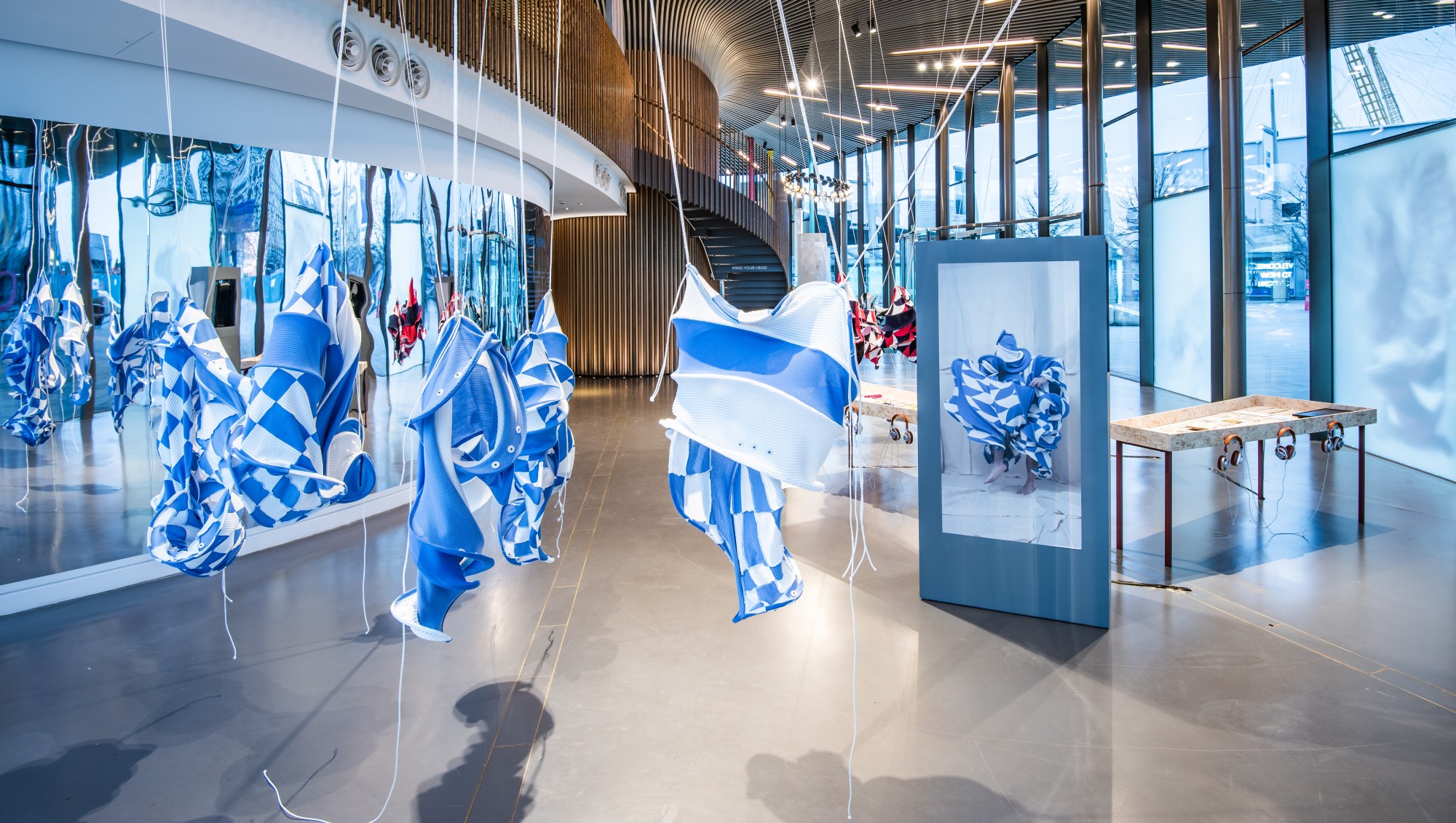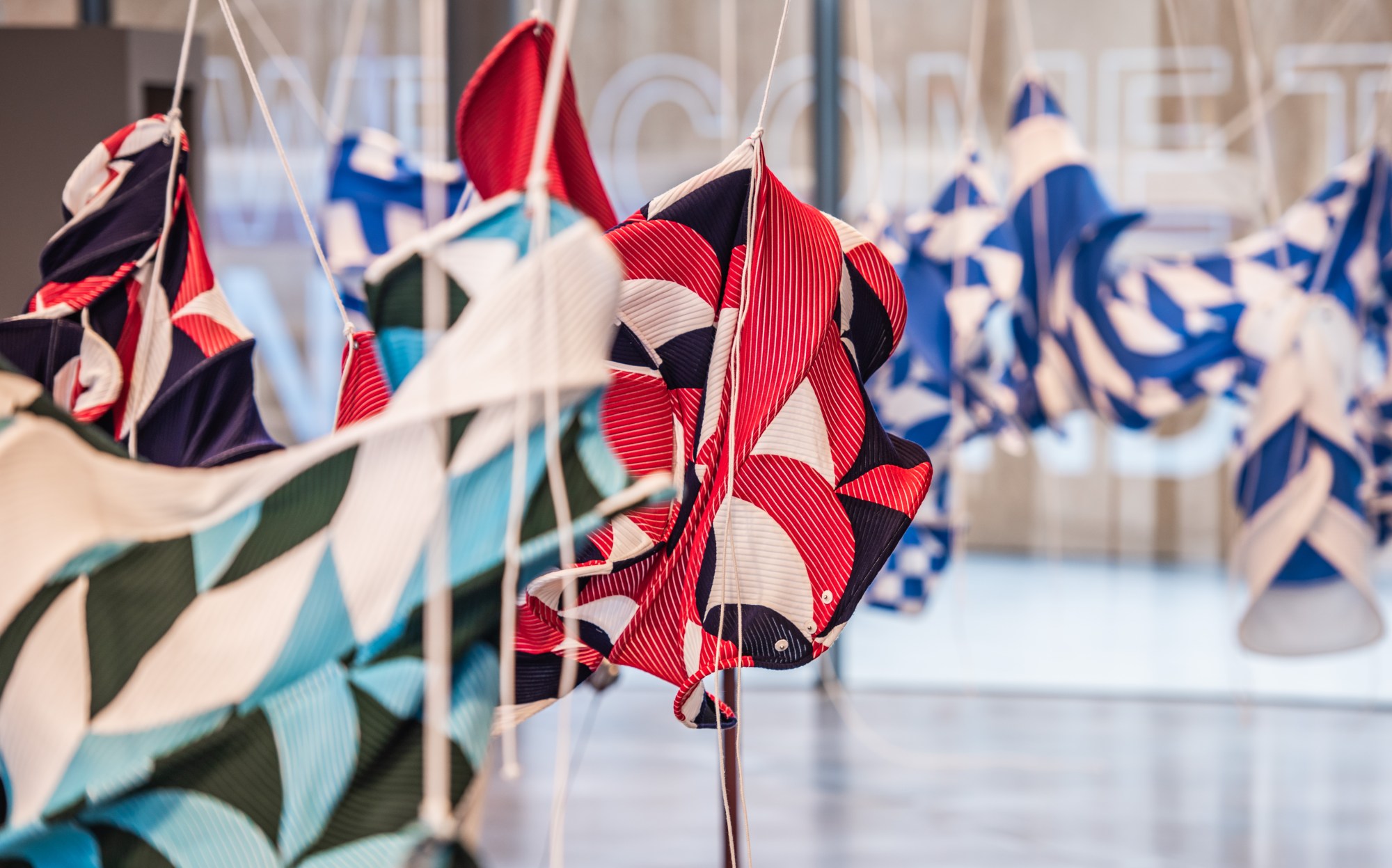From Molly Goddard’s 7-metre-long embroidered tulle dresses to Fred Butler’s pink foam contemplative space, the Greenwich Peninsula public exhibition space NOW Gallery continually encourages me, you and everyone we know to take part in its interactive installations. This winter, CSM and Fashion East graduate Richard Malone has been tasked with creating an extension of, and wider invitation inside, his wonderful world of sensitive form studies, of sociopolitical resistance and sustainable practice.
Inspired by the constant fluidity of the changing landscape of Greenwich Peninsula, the nearby cyclical motion of the River Thames, and pushing back against the quickening current of the fashion industry, Richard Malone’s debut exhibition, RINSE, REPEAT, is an immersive installation made up of three multi-disciplinary elements. While providing an invitation inside the wonderful world of one of London’s most resourceful and rebellious design talents, visitors are encouraged to join the conversation around fashion, movement and art. As the public begin to explore the space, climb into garments that hang from the ceiling, flick through sketchbooks that are scattered throughout the space and generally lose themselves inside his creative mind, Richard talks us through how he wants to turn fashion into an environment in which everyone feels welcome and respected.

What does the exhibition format allow that catwalk shows or presentations just can’t?
An overview of my practice. With a catwalk show you’re really restricted to an accepted format. Due to the nature of sponsorships and support systems here in London, you have to show in this way — it’s already part of a regimented system. I’ve never enjoyed catwalk images because of that restriction, people’s eyes are almost trained to skim over them and search for really known, obvious references, which doesn’t really allow for originality.
To what extent did the format challenge and free you?
It’s similar to the same way people interact with social media, it’s a very surface level way of digesting information or creativity. With this exhibition you get to see a lot of elements of my work that I’ve never show before, but that consistently inform my practice. Everything from initial sketches, to writing, fittings to photography and the actual cutting, the exhibition touches on sentimentality and a very honest way of acknowledging where I’m from, and the things that inform what I do.
The sculpted pieces we are showcasing are a way of framing the part of creating a collection for the viewer, where you’re trying everything on to make shapes, and to show how the possibilities are endless. I like the idea of the viewer being able to make this decision — the pieces are unlined, patchwork textile works that you can interact with or build around yourself, or snap together and leave as a form, it’s really up to you. It’s a way of democratising that process and not worrying about the result.
Throughout the exhibition space there’s a real sense of you celebrating the humanity and creativity within the art of fashion and the amazing women who help bring it to life. How important was it to remind people of this humanity?
It’s vital. I never really wanted to be a brand, and throughout doing this I’ve knowingly resisted the idea of designers having one ‘thing’. I always thought that was so ridiculous that you should come out of CSM with one ‘thing’ you can apply to a garment, and then continue to infect the world with that one vision. It’s a system that doesn’t allow the designer any autonomy over their career or their process, and it really restricts creativity and trust in your own instinct.
Is it difficult to listen to your instinct in an increasingly noisy industry?
It is and you can also get completely washed away once a trend finishes, so you should always resist. It’s really bizarre to expect designers to have one idea in their career, it’s part of a systemic problem that comes from the speed at which we’re expected to produce -– you’re almost allowing it and encouraging it by pandering to it. People say you should be able to describe a brand or a practice in three words or less — a catchphrase almost, all this nonsense about elevator pitch and blah blah — I think that’s fucking ridiculous. Nothing worthwhile, and certainly nothing human, can be described in three words or less, and if it can — work harder. We crave something now that makes us think, and we’re done being spoon fed.

It’s often overlooked but the craft of fashion is so important to you.
The biggest part of me pursuing this career is to allow myself to experiment, and to always, always be learning, not about business but about design, form and construction, cutting and finishing. I don’t want to be at the peak of my career until I’m about 70 to be honest, or later. I really do my best to resist that London hype thing. What I learn from actually making, and for working with real, inspiring women (and men) can’t really be valued in monetary terms, so I guess I don’t try. It’s also exciting for people to see what actually goes into this mental job, and how productive we are. You’ll also see a few private commissions and hear a few conversations with the women who support me.

How conscious are you of being at the front-lines of changing fashion for the better or at the very least to spark conversations of change?
I’m conscious of it, but I also try to resist being part of any group or new generation. I think we’re all really individual, and because of all our differences we really have very different work, so there’s no sense of competition — we can get on and support each other. There’s so much that needs to change for us to create an environment where everyone feels welcome and respected. I still don’t, even with accolades and the MoMa and all these things that have happened. Almost every room or corner you turn in fashion, it’s controlled by the elite, so it’s been quite hard to break into. Obviously it’s much easier to have a fashion brand in London if you’re rich, or to become a model if you’re parents are already ‘somebodys’. I think it’s a really depressing time to be from a place like where I grew up, because the possibility of a brilliant university is out of the question. l could not have pursued the same path today in this current climate. I feel like we’re continuously losing a huge group of brilliant, diverse, eager students since the fees went up, and it’s just getting worse.
It shows in the output of our universities, I think it’s a really dark time for creativity. That old saying that creatives are always responding to the times, and this notion that great work comes out of dark times can actually be total bullshit, because having the opportunity to create is such a huge privilege right now and we need to find a solution. If you’re from a working class background it’s just not happening, very few people today are from this background in our industry. We need these corporations, who rely on our talent, to put their hands in their pockets and up those scholarships. We also need to look outward, we need to go to these places outside of London and show them the opportunity, inspire them a bit because I can imagine it feels totally impossible.

And what about the sustainability aspect?
Sustainability is a funny term, people are applying it to literally anything now, like the Burberry office having eco coffee cups when they’re burning all that stock (like most luxury brands do and they’ve since stopped after recent criticism), and this also comes down to education. If we start teaching young people about how toxic this industry is to our planet, or to mental health and socioeconomic disparity, they will react — they’ll change spending habits, reconsider how they buy and inevitably if this affects sales, that’s when the big businesses will listen and respond, and when you’ll actually be able to see change. You have to make them aware that you don’t want a part of it.
The entire concept of luxury is changing from this archaic idea of excess, crocodile handbags and fur coats, to actually using our intellect to solve problems, to buy less, to challenge — because it’s actually gone too far now, and we have a responsibility to do something good and to learn from it. There’s a lot of talk about Populism in politics right now, but that is completely, comically replicated in fashion. Incredible brands have been reduced to a couple of logo hats or clunky trainers to promote a false sense of identity or security on social media, and it’s sad and also dangerous. We have to be careful and look after each other, and not be ashamed of all our different facets and backgrounds. Supporting each other is really important now, and allowing yourself to be happy and to look up to your peers.

The current fashion landscape is trouble and the future is uncertain but what excites you most about tomorrow?
The industry that we’re slowly creating. I think we’re at a peak low right now, but in a few years we should see these seeds of change taking shape. I’m excited about our creative industries opening the dialogue, and allowing disciplines to crossover and be considered art, or design or architecture or whatever. It’s challenging and exciting. Never in a million years did I think that 3 years out of CSM, I’d be in the permanent collection of the MoMA alongside Pollock or Louise Bourgeois, it’s mind blowing.
I’m incredibly inspired by, and enamoured with, my own peers, they excite me about the future. I feel like there’s a group of us young designers (definitely not all of us), who really honestly support each other and have completely eliminated that insular sense of competition and archaism that used to be surrounding designers, and was obviously toxic and damaging. We’re having really important conversations, helping each other, and just generally creating a community that feels totally new. The industry is bound to catch up, sooner or later.
RINSE/REPEAT is on at NOW Gallery, London, until January 27 2019
